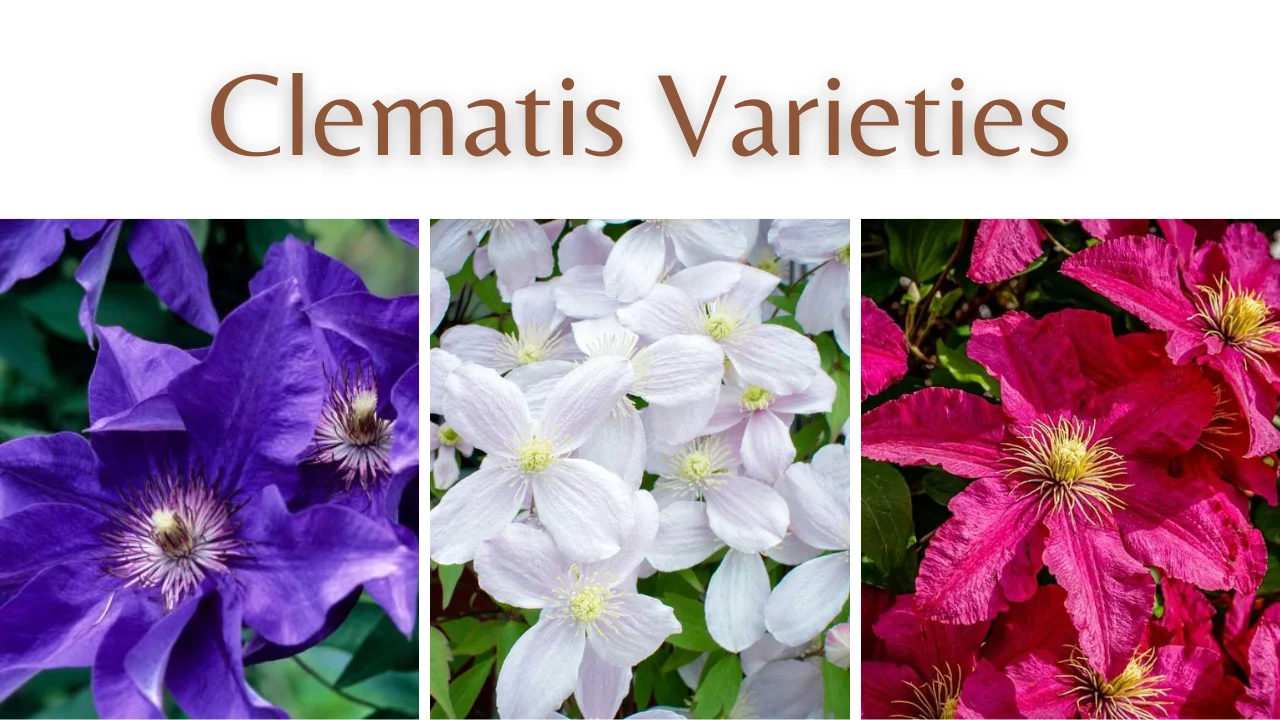Clematis varieties offer a captivating and diverse world of flowering vines within the Clematis genus, enticing gardeners and horticulture enthusiasts with their beauty and versatility.
These remarkable plants are renowned for their stunning blooms, which come in various colors, shapes, and sizes, making them a beloved choice for gardens, arbors, and trellises.
From the classic and ever-popular Clematis ‘Nelly Moser’ with its delicate pink and mauve petals to the vibrant purple hues of ‘Jackmanii,’ there’s a Clematis variety to suit every garden aesthetic.
Some varieties, like the Clematis ‘Sweet Autumn,’ delight with their fragrant blossoms, while others, such as the ‘Armandii,’ offer evergreen foliage for year-round interest.
Whether adorning fences, climbing walls, or sprawling gracefully through trees, these enchanting vines elevate garden design and enchant all who behold them.
Exploring Clematis varieties unveils a world of possibilities for adding vertical interest and splashes of color to outdoor spaces.
Different Clematis Varieties
Following are Clematis varieties:
1: Nelly Moser’ Clematis

Source Pinterest
The Nelly Moser Clematis, also known as the Early Large-Flowered Clematis, is a fan-favorite among gardeners for its early-season pink blooms.
The first, bigger flush of blooms appears in the late spring to early summer, and the second, smaller flush appears in the late summer to early autumn.
This Clematis is simple to cultivate and tends to bloom twice over the growing season. Like most other types of Clematis, the Nelly Moser clematis does best in full sun to partial shade and requires evenly wet, well-drained soil. This type, which can grow up to ten feet in height, is perfect for a trellis or fence covering.
2: Clematis Montana
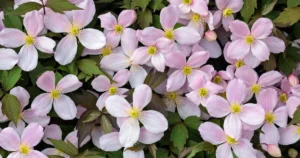
Source Pinterest
Clematis Montana describes a larger group of Clematis, including many distinct species and cultivars. All of these species have an exceptional capacity for vertical growth; in certain cases, they may reach heights of 40 feet and widths of 15 feet.
These clematises, native to China, feature pink or white flowers of varied sizes and like partial shade to full sun and wet, well-drained soil.
This Clematis are no different from other varieties of that they like to have their “heads in the sun and feet in the shade,” so planting them in an area with plenty of mulch or some big rocks will help provide that much-needed shade.
3: Florida clematis
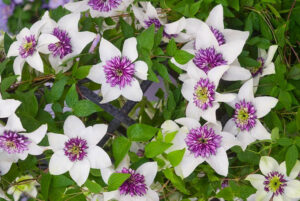
Source Pinterest
As its name implies, the Florida clematis does well in regions with moderate winters and hot summers. This deciduous vine blooms once in early to mid-June, late October or early November and again in early- to mid-April autumn if you deadhead it after the first bloom.
The Florida clematis is a fast-grower that may reach six to eight feet. Growing this Clematis in full sun with built-in shade around the base (such as rocks or heavy mulching) will produce far better flowers than growing it in half shade.
4: Armand Clematis
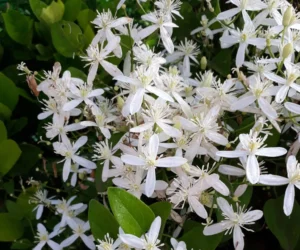
Source Pinterest
The Armand Clematis, scientifically known as Clematis armandii, is a captivating evergreen vine appreciated for its lush, year-round foliage and fragrant, star-shaped white blossoms.
Native to China, this vigorous climber can quickly cover trellises, arbors, and walls, making it a popular choice for garden enthusiasts seeking greenery and beauty throughout the seasons.
Its glossy, dark green leaves provide an elegant backdrop for aromatic flowers that appear in early spring. Armand Clematis requires proper support for its vigorous growth and thrives in well-drained soil with partial to full sunlight, making it a splendid addition to gardens and landscapes.
5: Alpine Clematis
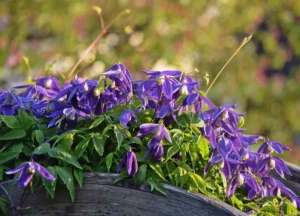
Source Pinterest
The Alpine Clematis is a hardy kind that often produces its first flush of blooms in May, living up to its well-titled status.
This Clematis, which prefers cooler climates, develops at a more sedate pace, maturing to a height of six, having a height of ten feet, a diameter ranging from three to six feet, and a diameter of three to six feet.
Like many northern types, this variety of Clematis does well in full to partial shade and wet, rich soil. You may skip the trimming and enjoy this cultivar’s nodding pink or blue flowers since it blooms on old foliage.
6: Duchess of Edinburgh’s Clematis
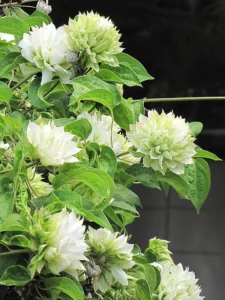
Source Pinterest
This early-blooming Clematis is hardy in the north and prefers wet, well-drained soil in full sun or partial shade. This variety’s enormous, brilliant white flowers are one of its greatest features. Their diameters range from four to six inches.
This resilient pollinator may reach a height of 12 feet, making it perfect for use as a huge trellis, arbor, or pergola.
Because the blossoms of this clematis type bloom on new growth, do your pruning in the late winter or early spring. After the first flush, you may repeat the pruning process to stimulate a second flush.
7: Texas Clematis
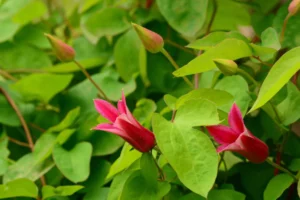
Source Pinterest
The Texas Clematis, often known as the Scarlet Clematis or by its Latin name, is a cold- and drought-resistant cultivar native to the Lone Star State.
This clematis type is prized for the striking contrast between its blue-green foliage and the fiery red petals of its flowers; it may reach a width of three feet and a height of fifteen feet.
Like many of the other Clematis on our list, Texas Clematis thrives in full sun or partial shade and does best when planted in nutrient-rich, well-drained soil.
Midsummer to early autumn flowers may be achieved by “hard pruning” this Clematis to a set of healthy buds in early spring.
8: Pearl of the South Clematis
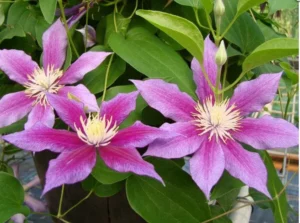
Source Pinterest
Pearl of the South Clematis, scientifically known as Pearl of the South Clematis, is a charming and popular flowering vine. It is celebrated for its stunning, rich blue-violet blooms that appear in late spring to early summer, adding a splash of vibrant color to gardens, trellises, and walls.
This vigorous climber thrives in well-drained soil and enjoys full sun to partial shade. Prized for its beauty and versatility, Perle d’Azur Clematis is an excellent choice for novice and experienced gardeners looking to enhance their outdoor spaces with enchanting flowers and lush foliage.
Like many others, the ‘Perle d’Azur Clematis grows well in full to partial sunlight and wet, well-drained soil, reaches heights of 12 feet, and blooms early in the growing season. These spectacular vines bloom from midsummer to late autumn and benefit from early spring pruning.
9: Orange Peel Clematis
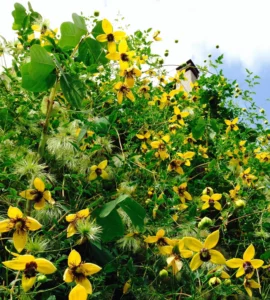
Source Pinterest
One of the most unusual-looking is the Orange Peel Clematis, also known as the Golden Clematis or Old Man’s Beard Clematis. Its names likely come from the thick yellow petals and the fluffy mass of seedpods it develops later in the season.
This kind does best in full sun with deep root protection. This hardy perennial vine may grow up to 15 feet tall and is a popular nectar source for pollinators like butterflies and hummingbirds.
10: ‘Henryi’ Clematis
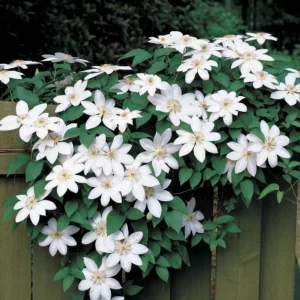
Source Pinterest
The ‘Henryi’ Clematis, often called early huge-flowered Clematis, has huge, white flowers that may reach a diameter of eight inches.
This Clematis can survive in colder climates and grow up to 15 feet long, making it a great climber with enormous, spectacular blossoms to drape over any of your garden structures.
It does best in full light, moist soil, consistent trimming, and frequent deadheading to coax a second bloom. Remember that any contact with the clematis plant necessitates using protective gloves since the whole plant is toxic.

